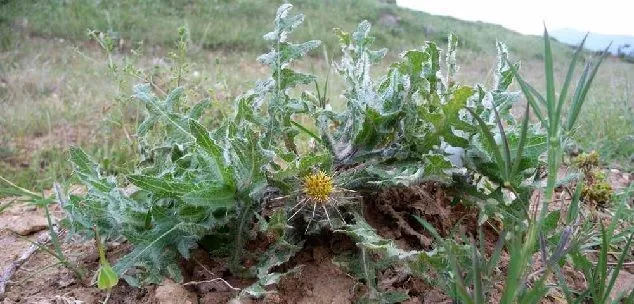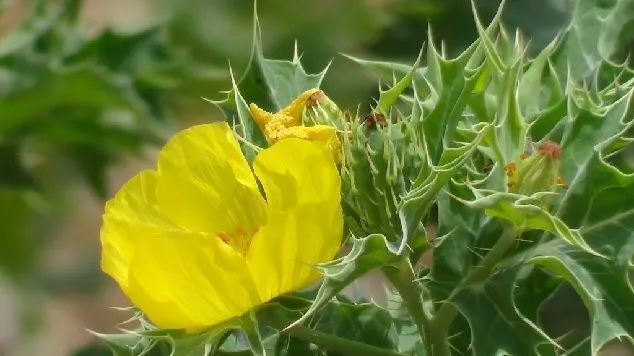
His name is holy. Holy thistle (Cnicus benedictus), belonging to the family Asteraceae. A plant that, to the naked eye, may be associated with a weed.
It is known as such given the medicinal properties formerly known, who considered it as a holy or miraculous plant. Thus derives its specific name, Benedictus, of blessed or blessing.
In other regions, they have replaced the word holy with blessed, knowing the plant as blessed thistle.
There is an unconfirmed story of its evidence, where Emperor Frederick III baptized it that way because it was offered to him as a safe migraine remedy, and it worked.
Currently the holy thistle participates as an ingredient in the elaboration of alcoholic beverages. For example, in certain homemade vermouths, Cnicus benedictus it is present in small quantities.
Table of Contents
Characteristics of Cnicus benedictus and its cultivation
Blessed thistle is native to the Asian continent. From there, it was transported and spread by all the great civilizations.
The area where it settled the most was in the Mediterranean basin, where it was widely used throughout Europe.
It grows feral in the Mediterranean area, in sandy or stony soils, and is a totally rustic species adapted to the environment.
Its propagation is by seeds, which are dispersed by wind or animal action.
Originally from Asia, from which it was imported, it is currently widespread in all coastal regions of the Mediterranean.

Active substances of holy thistle
- Sesquiterpene lactones (germacranolide: cnicine)
- Flavonoids: glycosides of apigenol, luteol and kenferol.
- Traces of essential oil (triterpenic and steroidic).
- Tannins
- Abundant mineral salts (10 to 20%) and potassium salts.
- Traces of alkaloids in the fruits.
- Heterosides
- Cnicina
- Arctigenin
There are several compounds of a bitter nature that are being studied for their possible effect as a diuretic, antibiotic, hypoglycemic and anti-inflammatory.
What is currently known is that it may have antifungal and antibacterial activity, or at least bacteriostatic.
Learning to use Cnicus benedictus
The most common and traditional ways to take advantage of the medicinal benefits of holy thistle are through decoctions of the aerial part of the plant
Decoction of holy thistle
The aerial part of the plant, such as flowers, is selected, weighing 10 grams for each liter of water to be boiled. Just before boiling it is added, letting the mixture rest for at least 10 minutes.
It can be taken 1 or 2 times a day, before or after meals. Externally, using a cloth or compress, the parts of the skin that need to be treated are rubbed.
The holy thistle grass we can buy it in any establishment related to medicinal plants.
Medicinal properties of blessed thistle
Healing of wounds and ulcers
In the past, holy thistle soaked in gauze was used to reduce treatments for acne, boils, small wounds in the process of healing and ulcers.
Given some of its compounds, such as tannins and heterosides, it has good healing action, used in some products sold in pharmacy and mixed with other medicinal plants of recognized prestige (such as rosehip).
The most common way to heal wounds is by tincture (alcoholic or non-alcoholic), with disinfectant and healing action.
Bacterial infections
Trials are currently underway to confirm the antimicrobial action of holy thistle extract. From the initial conclusions obtained it is known that it is effective for one type of microorganisms but ineffective for another.
This action can be combined with medicinal plants that have also been shown to be effective against the development of microorganisms and prevent infections, such as properties of thyme.
Treatment of indigestion
The reaction that causes the decoction of blessed thistle is to increase the secretion andstomacal and acidic juices. This can speed up transit and improve indigestion.
However, it causes the opposite reaction if the problem of indigestion comes from heartburn or acid reflux.
Diuretic action
Holy thistle extract may have some diuretic action relating it to the presence of some compounds.
This may be related to the bitterness of its compounds (tannins) and the acid reaction it causes in the stomach after consumption.
Something similar happens with the dandelion, another medicinal plant that also has diuretic properties.
However, there is still no clear evidence to confirm its use as a potential diuretic.
Increased appetite
Bitter substances provoke the increased appetite, with the aim of neutralizing the flavor. In addition, it activates the mucous secretions of the stomach and gastric juices and facilitates the entry of food.
It may be interesting, in periods of lack of appetite or anemia, to combine this medicinal plant with others (like horehound) before meals.
Contraindications of holy thistle
Some contraindications have been studied depending on the person who consumes this medicinal plant.
Pregnant and breastfeeding people
Although no conclusions have been reached, it is recommended that its consumption be avoided pregnant people and in lactation period.
Intestinal problems
Due to the high presence of tannins, its consumption is not recommended to people with gastric problems (infections, inflammatory disorders, Crohn’s disease, etc.). Its consumption can irritate the stomach and digestive mucosa.
Antacids
The consumption of holy thistle can cause acidity in the stomach, but without causing discomfort. Therefore, people who regularly take antacids can limit their effect.
It is not recommended to take, for a long time, doses higher than 5 grams a day, as it could cause perforations of the stomach, esophagus and other organs.
Bibliography consulted
- Vanhaelen M and Vanhaelen-Fastre R. Lactonic lignans from Cnicus benedictus. Phytochemistry 1975;14:2709.
- Ulbelen A and Berkan T. Triterpenic and steroidal compounds of Cnicus benedictus. Planta Medica 1977;31:375-377.
- Kataria H. Phytochemical investigation of medicinal plant Cnicus wallichii and Cnicus benedictus L. Asian J Chem 1995;7:227-228.
- Pfeiffer K, Trumm S, Eich E, and et al. HIV-1 integrase as a target for anti-HIV drugs. Arch STD/HIV Res 1999;6:27-33.
